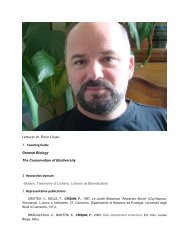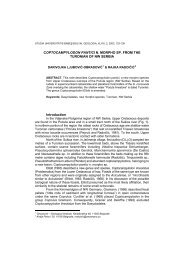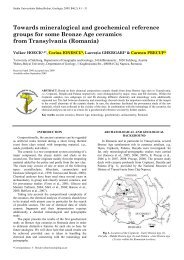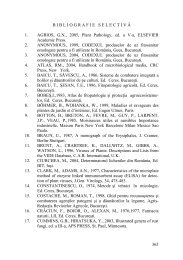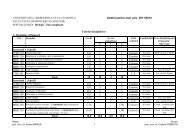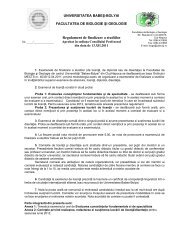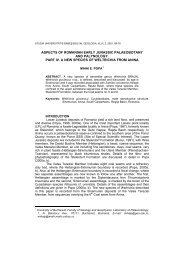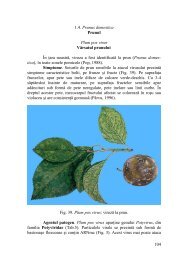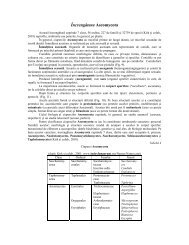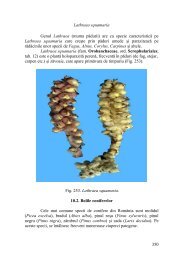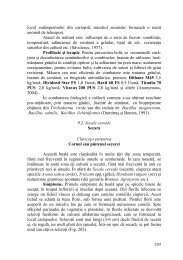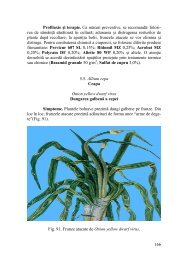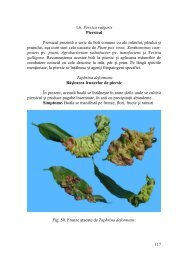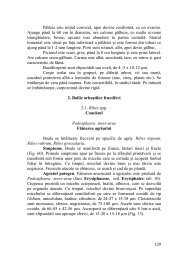paleoenvironmental setting of rudists in the upper cretaceous
paleoenvironmental setting of rudists in the upper cretaceous
paleoenvironmental setting of rudists in the upper cretaceous
Create successful ePaper yourself
Turn your PDF publications into a flip-book with our unique Google optimized e-Paper software.
types; polished slabs have been used for <strong>rudists</strong>’<br />
identification. The characteristic features <strong>of</strong> <strong>the</strong><br />
rudist associations were used for bi<strong>of</strong>acies <strong>in</strong>terpretation.<br />
By corroborat<strong>in</strong>g paleontological, micr<strong>of</strong>acies,<br />
sedimentological and biostratigraphical<br />
data, we could propose <strong>the</strong> <strong>paleoenvironmental</strong> reconstruction<br />
for <strong>the</strong> Upper Cretaceous <strong>in</strong> <strong>the</strong> study<br />
area.<br />
Fig. 1. Location <strong>of</strong> <strong>the</strong> studied area. Legend: 1-Magmatic<br />
rocks; 2-Proterozoic rocks (Seria de Somes); 3-Triassic<br />
deposits; 4-Jurassic deposits; 5-Upper Cretaceous<br />
deposits; 6-Miocene deposits; 7-Quaternary deposits;<br />
8-location <strong>of</strong> <strong>the</strong> sedimentologic log <strong>in</strong> <strong>the</strong> Upper Cretaceous<br />
deposits from Valea Neagră de Criş.<br />
2. Stratigraphy and sedimentary facies<br />
The Upper Cretaceous deposits <strong>in</strong> Gosau facies<br />
along <strong>the</strong> right flank <strong>of</strong> Pietrelor de Moară Brook<br />
crop out along a stratigraphical succession <strong>of</strong> about<br />
45 meters thick. The lower part <strong>of</strong> <strong>the</strong> pr<strong>of</strong>ile is<br />
characterized by an alternation <strong>of</strong> conglomerate/microconglomerate<br />
levels and bioconstructions<br />
with Vacc<strong>in</strong>ites. The sequence starts<br />
with a conglomerate horizon ~0.50 m thick, on<br />
<strong>the</strong> top <strong>of</strong> which, after a gap, <strong>the</strong> first bioconstructions<br />
with Vacc<strong>in</strong>ites, 0.80 m thick,<br />
are <strong>in</strong>stalled. These are covered on top by ano<strong>the</strong>r<br />
microconglomerate level <strong>of</strong> 0.50 m. The<br />
follow<strong>in</strong>g two bioconstructions with Vacc<strong>in</strong>ites<br />
(~2 and respectively 3 m thick) are also<br />
covered by conglomerate/microconglo-merate<br />
levels.<br />
102<br />
The median part <strong>of</strong> <strong>the</strong> pr<strong>of</strong>ile is dom<strong>in</strong>ated by<br />
siliciclastic deposits. These deposits are represented<br />
by conglomerates, microconglo-merates<br />
and bioclastic sandstones, erosionally overlaid.<br />
In <strong>the</strong> <strong>upper</strong> part <strong>of</strong> <strong>the</strong> pr<strong>of</strong>ile, a few levels<br />
with bioaccumulations dom<strong>in</strong>ated by radiolitids<br />
<strong>in</strong>tercalated <strong>in</strong> siliciclastic deposits crop<br />
out.<br />
Two facies types with <strong>rudists</strong> (Fig. 2) could be<br />
separated with<strong>in</strong> <strong>the</strong> studied succession: 1) bioconstructions<br />
with Vacc<strong>in</strong>ites (Fig. 3a-d) and 2) bioaccumulations<br />
dom<strong>in</strong>ated by radiolitids (Fig. 3e).<br />
1) In <strong>the</strong> lower part <strong>of</strong> <strong>the</strong> pr<strong>of</strong>ile, <strong>the</strong> bioconstruction<br />
consists <strong>of</strong> floatstone with Vacc<strong>in</strong>ites and Plagioptychus<br />
and a fraction <strong>of</strong> small-sized biota (red<br />
algae, foram<strong>in</strong>ifers, brachiopod fragments). The<br />
<strong>rudists</strong>’ shells can be considered <strong>in</strong> growthposition.<br />
The Vacc<strong>in</strong>ites skeletons are slender and<br />
reach more than 15-20 cm <strong>in</strong> length. Locally, between<br />
<strong>the</strong> clusters <strong>of</strong> Vacc<strong>in</strong>ites, Plagioptychus,<br />
small radiolitids (Lapeirousia sp.) and small coral<br />
heads are <strong>in</strong>tercalated.<br />
The association <strong>of</strong> <strong>rudists</strong> is dom<strong>in</strong>ated by Vacc<strong>in</strong>ites<br />
species: V. gosaviensis DOUVILLE (Fig.<br />
4d), V. sulcatus DEFRANCE (Fig. 4a,b,c,d) and<br />
very rare specimens <strong>of</strong> V. oppeli DOUVILLE,<br />
Vacc<strong>in</strong>ites <strong>in</strong>aequicostatus MUNSTER and Hippurites<br />
nabres<strong>in</strong>ensis FUTTERER (Fig. 4c). At <strong>the</strong><br />
base <strong>of</strong> <strong>the</strong> bioconstruction, Plagioptychus paradoxus<br />
MATHERON and Plagioptychus sp. are<br />
more abundant. This association po<strong>in</strong>ts to <strong>the</strong> Upper<br />
Santonian–Lower Campanian <strong>in</strong>terval.<br />
2) In <strong>the</strong> <strong>upper</strong> part <strong>of</strong> <strong>the</strong> pr<strong>of</strong>ile radiolitids are<br />
dom<strong>in</strong>ant. Radiolitid-rich bioaccumulations are<br />
present at various levels, <strong>in</strong>terlayered with<strong>in</strong> siliciclastic<br />
deposits. The <strong>in</strong>ternal sediment <strong>of</strong> <strong>the</strong> bioconstructions<br />
is represented by extraclasticbioclastic<br />
wackestone-packstone with encrust<strong>in</strong>g<br />
red algae, foram<strong>in</strong>ifers encrust<strong>in</strong>g rudist fragments,<br />
benthonic foram<strong>in</strong>ifers and very rarely coral fragments.<br />
Among <strong>the</strong> radiolitids, <strong>the</strong> follow<strong>in</strong>g taxa have<br />
been recognized: Miseia pajaudi PATRULIUS<br />
(Fig. 4e), Miseia sp. (Fig. 4k), Lapeirousia sp.<br />
(Fig. 4h), Radiolites subsquamosus TOUCAS, Radiolites<br />
mammilaris MATHERON, Praeradiolites<br />
aristidis MUNIER-CHALMAS, Praeradiolites<br />
subtoucasi TOUCAS (Fig. 4l), Sauvagesia tenuicostata<br />
POLSAK, Bournonia excavata<br />
d’ORBIGNY, Gorjanovicia polsaki ÖZER, Gorjanovicia<br />
costata POLSAK (Fig. 4i). Among pla-



